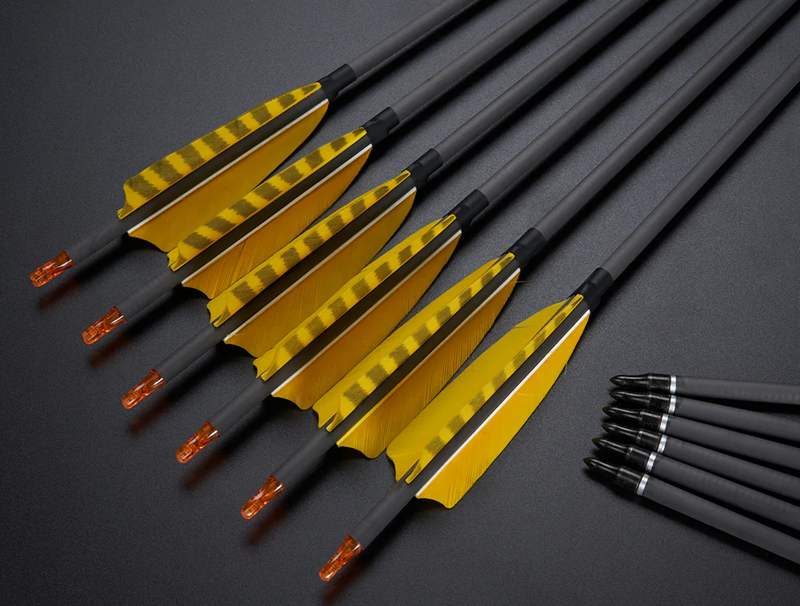Hunting with a bow and arrow is a mix of skill, accuracy, and gear. One of the most important decisions you'll make is choosing the right arrow and broadhead for your bow setup, as this can really impact your success in the field. With so many options out there, it can be overwhelming to find the right hunting arrow.
Types of Arrows for Hunting
Carbon Arrows
Carbon hunting arrows are popular among hunters because they’re tough, precise, and lightweight. As the name suggests, they're made with a carbon fibre core, they resist bending or breaking better than traditional arrows. They also tend to fly faster and flatter, making them perfect for those longer shots. These arrows come in various diameters, including micro and ultra-micro, which enhance penetration. The downside is that they can be pricier than other arrow types.
Aluminium Arrows
Before carbon arrows took the spotlight, aluminium arrows were the main choice for hunters. They’re still a favourite today because they’re budget-friendly and easy to find. An aluminium hunting arrow is quite durable, making it great for heavier draw weights or shooting at tough targets. However, they are generally heavier than carbon arrows, which can impact how they fly.
Carbon/Aluminium Hybrid Arrows
If you want the best of both worlds, these arrows are a great choice. They have a carbon core wrapped in an aluminium layer, combining the lightweight and precision of carbon with the toughness and penetration of aluminium. These are best for serious hunting or when you need a heavier arrow for deep penetration.
Wood Arrows
Wood arrows have been used for ages and are still a popular choice with traditional archers. They're crafted from high-quality hardwoods such as cedar or ash, they can be tailored to fit the archer’s style. While they tend to be slower and heavier than carbon or aluminium arrows, they give that classic vibe many archers love. Wood arrows should only be used with recurve or longbows since they can’t handle the high speeds of modern compound bows.
Types of Broadheads for Hunting
Fixed-Blade Broadheads
Fixed-blade broadheads have been used for a long time and are still a favourite among traditional archers. They have blades permanently attached to the ferrule, making them very durable and reliable since there are fewer moving parts. However, they might need a bit more tuning to ensure they fly straight, and sharpening them can be a bit tricky. Within this category, you’ll find various tip styles and some that come with replaceable blades. Fixed-blade broadheads are great for a wide range of game, including turkey, coyotes, and deer. They’re especially recommended for more challenging animals like buffalo, grizzly bears, moose, and elk.
Mechanical Broadheads
Mechanical broadheads, or expandable broadheads, gained popularity lately because of their accuracy and penetration power. These broadheads have blades that stay closed during flight and open up when they hit the target. They’re usually more aerodynamic than fixed-blade options and tend to fly more consistently. However, their moving parts can make them a bit less reliable. Mechanical broadheads are effective for many of the same animals as fixed-blades, like turkey, deer, pronghorn, and coyotes. There’s some debate about using them on larger game like elk and bears, so it really comes down to personal preference and local regulations.
Hybrid Broadheads
Hybrid broadheads bring the best of both world, combining fixed-blade durability with mechanical blade penetration. They have the reliability of a fixed blade but also give the benefits of mechanical blades for better penetration.
Matching Arrow Spine to Broadhead Weight
Arrow spine refers to how stiff the arrow is, and it's important to match it with the weight of the broadhead you're using. If the spine is too weak for the broadhead, the arrow will bend a lot, leading to unstable flight and less accuracy. Conversely, if the spine is too stiff, the arrow won't flex enough, which can also mess with your flight and accuracy.
When you're matching the spine to your broadhead weight, think about what you're hunting and the typical distance you'll be shooting. For example, if you're going after bears, you're likely taking shorter shots at a hefty animal. Using a 125-grain broadhead instead of a 100-grain one will add weight to your arrow, improving penetration.
Testing and Tuning Your Arrows and Broadheads
After you've matched the arrow spine to the broadhead weight, the next step is to test and fine-tune your setup for the best performance. This means shooting a bunch of arrows with your selected broadheads and tweaking the arrow rest, nocking point, and other settings until you get tight groups and consistent flight. It might take some time and patience, but putting in the effort is worth it to make sure your arrows and broadheads are working at their peak.